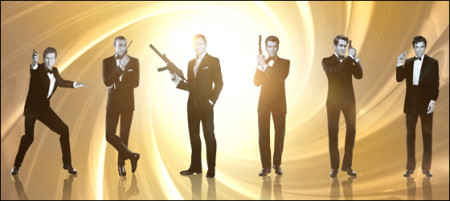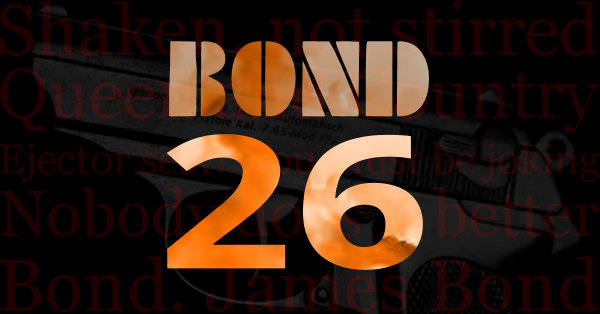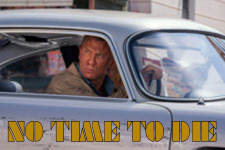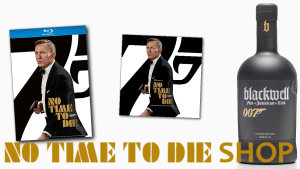Eoghan Lyng takes a look at why the theory held by some fans that “James Bond” is just a code name used by a number of different agents over the years just doesn’t hold water.

Image: from cover art of Bond 50 22 film Blu-Ray box set, available from Amazon UK and Amazon.com.
Some people have too much time on their hands. There are Led Zeppelin theorists who claim Robert Plant recorded subliminal Satanic messages on Stairway To Heaven, there are those who still insist Elvis Presley is alive and well, and there are those who think “James Bond” is a codename much like M, Q or, indeed, 007. Whatever the validation of the other two (it is almost certain Elvis is still alive and living in Manchester. How could he not? ), “James Bond” is not a code name given to Her Majesty’s best agent.
James Bond is a character of literary and cinematic iconography, much as Sherlock Holmes and Batman are. Whether the character of Holmes is played by Basil Rathbone, Benedict Cumberbatch or Roger Moore, it’s pretty clear the character is the same sharp, judicious detective played by all; nobody has ever tried to tie those three portrayals for the character together as some sort of conspiratorial indictment that could only happen on screen. As for James Bond, the series is an assortment of frames dedicated to the adulation of blonde haired cello players, exploding pens, underwater palaces and planes shooting out of horse boxes. Surely such meticulous calculation is itself illogical, given the asinine nature of the series?
Now there are two cinematic indicators which feed this theorist movement the meat they ravenously seek, one being from Charles K Feldman’s Casino Royale (1967) and a line from On Her Majesty’s Service (1969). Royale features David Niven’s character commenting on a successor agent that currently has his name; Majesty features the famous one liner “this never happened to the other fella”.
Okay, Feldman’s film is a comedy he made when negotiations with Albert R Broccoli and Harry Saltzman fell sour, this reference is an out and out dig at EON, a childish one, but a dig none the less. The film also features Woody Allen as a villain; little of the film can be regarded as gospel truth. As for George Lazenby’s one liner, it’s an unfortunate choice. A cheap wall-breaker that showed little of Richard Maibaum’s genuine wit, it’s a wall-breaker meant as a cheap laugh; an ice breaker for the new face. After all, he was following Sean Connery!
Connery, the man every man wanted to be, every woman wanted under her sheets. Doubtless he played a different secret agent in his first five films also! Sean Connery would leave the series and as celluloid history would indicate, George Lazenby would portray Fleming’s secret agent. Granted the film does contain that odious one liner “this never happened to the other fella”, which has been used as evidence to support the idea of multiple James Bond’s. This line in question was meant as a cheap throwaway of a line as an icebreaker, one to be forgotten instantly.
Bond Historian John Cork himself has indicated that the filmmakers consciously wanted another Sean Connery, not a new part. The whole basis of OHMSS is that James Bond has been chasing Ernst Stavro Blofeld following many misadventures over the previous five films; Lazenby’s scouring over previous artefacts (Red Grant’s watch, Honey Ryder’s knife and gadgets from Thunderball) with fondness is validation that he is the same James Bond as Connery. As John Kenneth Muir said, this would prove to be the most important chapter in the Bond anthology and would itself be referenced with great frequency to validate the next three Bond actors.
Next up, Roger Moore. True, his foxy red hair was a complete contrast to Lazenby and Connery, and his gentlemanly mannerisms a contrast to the animal ferocity of the other two, but again, he is the same celluloid James Bond. Fair enough he drives a Lotus Esprit and wears safari suits, but still the same Bond. He shares ghost -stories with Quarrel Jr in Live And Let Die, a clear reference to the work he sat through with his father in Dr No.
Unconvinced? What about the opening of For Your Eyes Only, where an ageing, grieving Bond places flowers on the grave of Tracy Bond? Is he really placing them there for a secret agent who lost his wife in 1969? Hardly. Ergo, Connery, Lazenby and Moore’s Bond are, you guessed it, the same Bond. As Moore was actually older than Connery, it makes sense that the fourteen films that occur could very well have been in chronological order, in terms of age and stature.
Understandably, Timothy Dalton poses a question. Visibly twenty years younger than Roger Moore, one could question if he was the same agent who killed Dr No in 1962. But The Living Daylights opens in Vienna, a city ravaged by the Cold War, wherein Dalton’s Bond shows exceptional insight into the mindsets of the KGB Agents, indicating that he really is not the new kid on the block. Licence To Kill goes one further to support this claim; Felix Leiter says that his old buddy was married once, but that was “long ago”. An out and out reference to Tracy Bond, the events in LTK are a reaction to the events in OHMSS, again a reminder that the film makers want their audience to respect this is the same Bond, even if the actor gets younger by the film?
As for Pierce Brosnan? There couldn’t be less to suggest that he isn’t the same Bond as the rest. He tells Judi Dench’s M what her predecessor drank, is reminded by Alec Trevalyan how his parents were killed in a ski-ing accident and has a talk with a female psychologist about his truancy behaviour, a nod to Bond going rogue in LTK. That’s all in Goldenye alone. Better still, he admits that his family motto is “The World Is Not Enough” in the eponymous film, a motto audiences first learned in, yes, OHMSS. Again, it reinforces how the great importance OHMSS holds in the Bond canon and, you guessed it, Brosnan’s the same Bond as Dalton, Moore et al.
As for the rebooted James Bond, yes it is difficult to connect Daniel Craig to the other actors, given that Barbara Broccolli and Michael G Wilson made a conscious decision to pull the plug and start again.
As much as Craig’s films have avoided continuity, they have, however, maintained contact with Ian Fleming’s books. Hell, Skyfall shows the grave of Bond’s parents, sufficient proof that this Bond, is still James Bond as christened, even if he lives in an alternative cinematic universe to the others that have preceded him. Judi Dench’s appearance may be a continuity irritant, but again, are people putting too much thought into her casting? The lady’s a solid actress; why re-cast another woman in the role when Dench is so good at it. It also adds another link to Brosnan’s Bond, giving Craig’s first two movies a certain degree of recognition when otherwise it would have been a polarising to see the film’s rebooted so heavily.
As nice as it would be to see, Timothy Dalton isn’t going to parachute down in SPECTRE to wish Craig luck as a continuation of the tradition, nor will Craig talk about past James Bond’s either. It’s a character worthy of reinvention and evolution; but he is and always will be, a martini drinking, Saville Row wearing, charming son-of-a-bitch viewers first watched in 1962.










February 19th, 2015 at 20:32
Excellent article. Another proof that Roger Moore played the same character of Bond as Connery is in TSWLM when Agent Amatsova mentions the death of his wife which clearly upsets Bond.
March 24th, 2015 at 14:53
Excellent article. Forgot about the scene of Bond putting flowers on Tracy Bond’s grave. In the book of OHMSS Fleming wrote about James annual trip to put flowers on the grave of Vespa, would be a great scene for Craig to do.
March 30th, 2015 at 20:04
I should have included that reference.
I imagine a whole thesis could be written about the importance Tracy´s shadow casts on the character of Bond.
Even ´Skyfall´, the death of M, feels like it is related to her death in terms of composition and the way it is written.